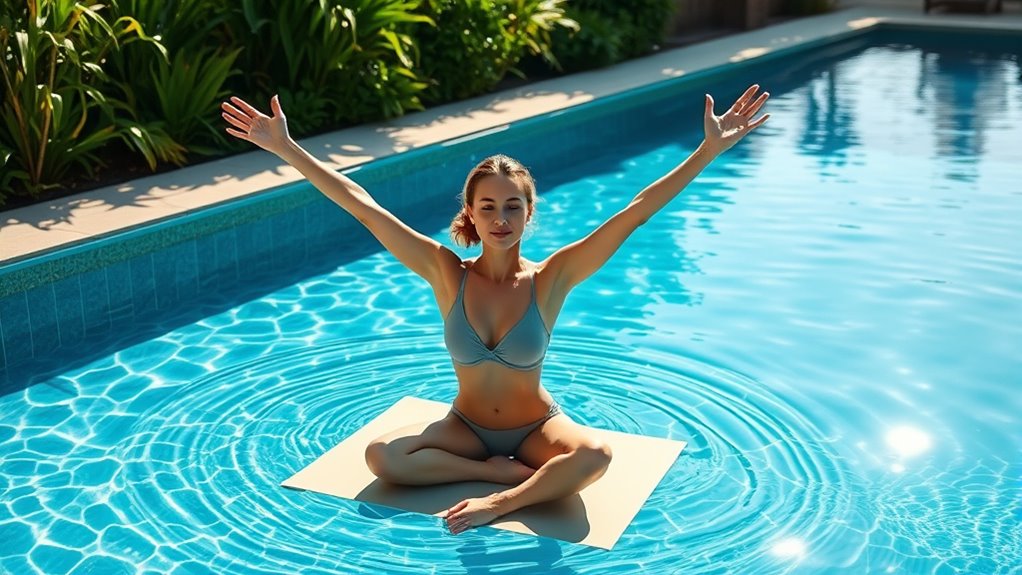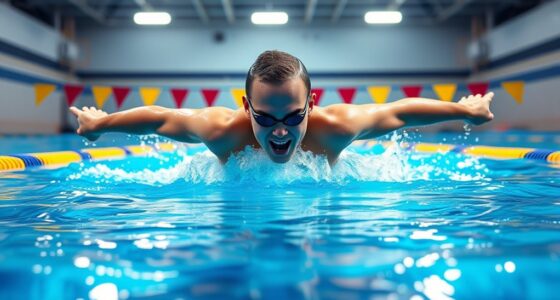Pool yoga offers gentle, low-impact routines that boost flexibility by combining water resistance, buoyancy, and mindful stretching. You’ll enjoy support for deeper stretches, reduced joint impact, and enhanced relaxation, making it ideal for all levels. Using proper equipment and safety practices guarantees a safe experience while warm-up and gentle stretches prepare your muscles. Keep practicing regularly, and you’ll discover how your flexibility and overall well-being improve—you’ll find plenty more tips if you continue exploring.
Key Takeaways
- Water’s buoyancy reduces joint stress, allowing gentle, low-impact stretching to improve flexibility safely.
- Incorporate slow, controlled movements like supported hip circles and shoulder stretches to deepen flexibility without strain.
- Use water resistance for muscle engagement while maintaining low-impact routines, enhancing flexibility and stability.
- Combine gentle warm-up exercises with deep breathing to relax muscles and maximize stretching effectiveness.
- Establish consistent routines with specific poses and timing to progressively enhance flexibility in a low-impact aquatic environment.
Benefits of Practicing Pool Yoga for Flexibility

Practicing pool yoga can considerably enhance your flexibility because the water provides gentle resistance that supports your movements. This resistance helps you stretch deeper without straining your muscles, making it easier to increase your range of motion. The buoyancy reduces the impact on your joints, allowing you to hold stretches longer and improve elasticity safely. As you move through poses, the water assists in stabilizing your body, helping you maintain proper alignment. Over time, this consistent practice lengthens muscles and tendons, leading to better flexibility overall. The soothing environment of the water also encourages relaxation, which can make your stretching sessions more effective. Additionally, the use of proper technique and equipment can further optimize your flexibility gains. Incorporating sound healing science techniques such as calming sounds or frequencies during your practice can promote deeper relaxation and muscle release. Engaging in mindful breathing techniques during your practice can enhance your flexibility by promoting relaxation and reducing muscle tension. Consistent practice in the water also supports muscle recovery, enabling you to progress more safely and effectively. With regular practice, you’ll notice increased mobility and a greater ease in performing everyday activities.
Essential Equipment and Safety Tips

To stay safe and comfortable during pool yoga, you need the right gear, like non-slip mats and comfortable swimwear. Always follow water safety practices, such as staying aware of your surroundings and not pushing beyond your limits. Ensuring proper equipment and safety measures helps you practice confidently and avoid accidents. Being aware of best equipment choices can further enhance your safety and comfort during your routine. Incorporating water safety guidelines into your practice can help prevent common issues and improve overall experience. Additionally, understanding Gold IRA rollovers can be beneficial for those interested in diversifying their retirement investments to secure their financial future. Using high-suction vacuums can also help maintain a clean and safe environment around your pool area. Following industry trends in pool safety equipment can keep you updated on the latest innovations to protect yourself and others.
Proper Gear Selection
Choosing the right gear is essential for a safe and enjoyable pool yoga experience. Start with a well-fitting swimsuit that provides support and comfort, allowing free movement without slipping. Consider using a pair of non-slip yoga shoes or water socks to enhance grip on wet surfaces and prevent falls. A waterproof yoga mat or foam pads can improve stability during poses, especially on poolside surfaces. Brightly colored accessories, like waterproof goggles or swim caps, boost visibility and safety. Don’t forget to wear a waterproof sunscreen to protect your skin from UV rays if practicing outdoors. Additionally, incorporating protective styling benefits such as secure accessories can help prevent distractions during your routine. Finally, keep a towel nearby to dry off and stay comfortable between poses. Proper gear ensures you stay safe, focused, and relaxed during your low-impact routine.
Water Safety Practices
Ensuring safety during pool yoga sessions starts with having the right equipment and following key safety tips. Always use a sturdy, non-slip mat designed for wet surfaces to prevent falls. Wear a properly fitted life jacket or floatation device if you’re a beginner or feeling nervous in the water. Never practice alone; always have a buddy nearby in case of emergencies. Keep your movements controlled and avoid sudden, jerky motions that could cause slips. Stay within your comfort zone and listen to your body to prevent strain. Be mindful of your surroundings, including pool depth and other swimmers. Additionally, understanding water safety practices can help prevent accidents and enhance your confidence during sessions. It is also beneficial to be aware of lifestyle considerations that can influence your overall safety and comfort in aquatic exercise. Recognizing environmental hazards in the pool area can further reduce the risk of accidents. Moreover, being aware of feature Buddies and their role in safety can improve preparedness during your routine. Having a clear plan for emergency procedures is essential for quick response if needed. Finally, make certain the pool area is clean, well-lit, and free of hazards. Following these safety practices helps you enjoy pool yoga safely and confidently.
Warm-Up Exercises to Prepare Your Body
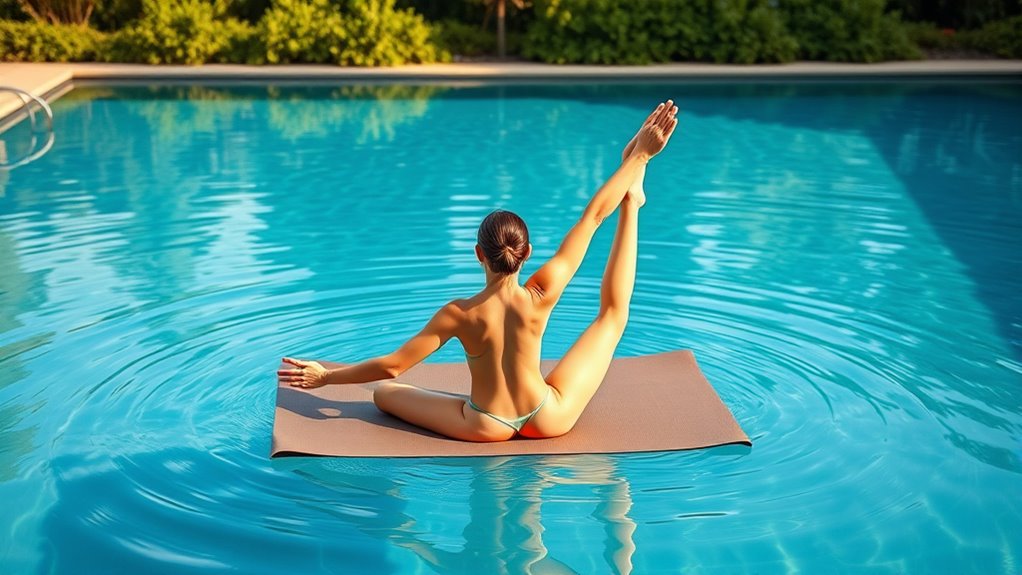
Before diving into your pool yoga session, it is crucial to start with some warm-up exercises that loosen your muscles and increase circulation. Begin with gentle arm circles to warm up your shoulders and improve mobility. Move on to slow torso twists, turning side to side to loosen your spine and core. Next, perform ankle rotations to prepare your lower limbs for movement. Incorporate light leg swings to activate your hip flexors and thighs. Focus on deep, steady breaths to oxygenate your muscles and calm your mind. These exercises should be slow and controlled, helping your body gradually adapt to the activity ahead. Additionally, incorporating suspension modifications can help improve your overall stability during movement. Proper warm-up enhances flexibility, reduces injury risk, and ensures you get the most benefit from your pool yoga routine.
Gentle Stretching Routines for Beginners
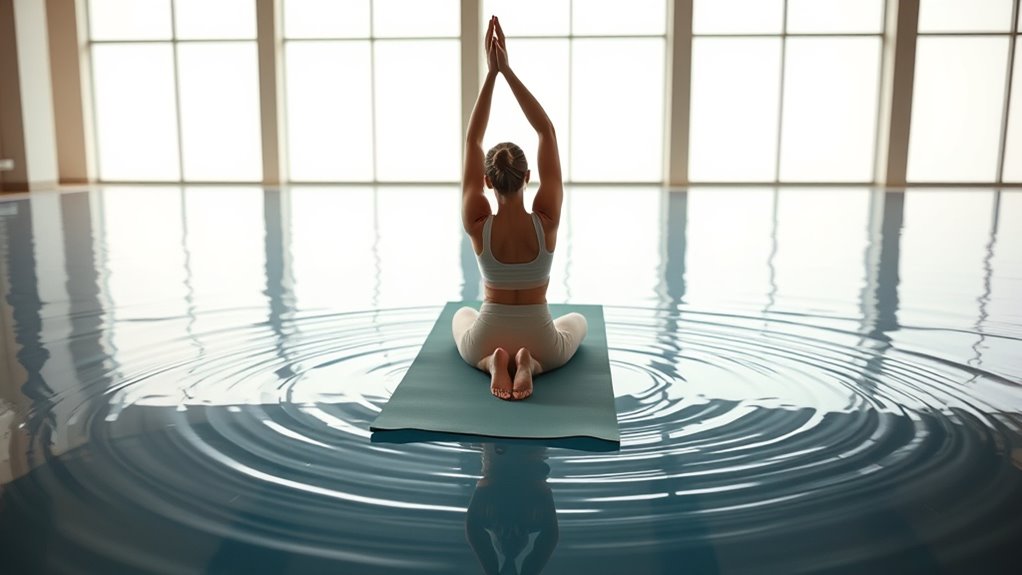
After completing your warm-up exercises, it’s time to gently stretch your muscles to enhance flexibility and relax your body. Focus on slow, controlled movements to avoid strain and increase blood flow. Start with simple stretches like arm circles or gentle torso twists to loosen up your shoulders and spine. Keep your movements smooth and breathe deeply with each stretch. Remember, the goal is to feel a gentle pull, not pain. These routines help improve your range of motion and prepare your muscles for more advanced poses later. Maintain relaxed shoulders and avoid locking your joints. Consistency is key, so incorporate these stretches into your regular pool yoga sessions for lasting flexibility benefits. Incorporating gentle stretching routines can also support your overall well-being and complement the benefits of AI-driven health recommendations.
Intermediate Pool Yoga Poses to Increase Range of Motion
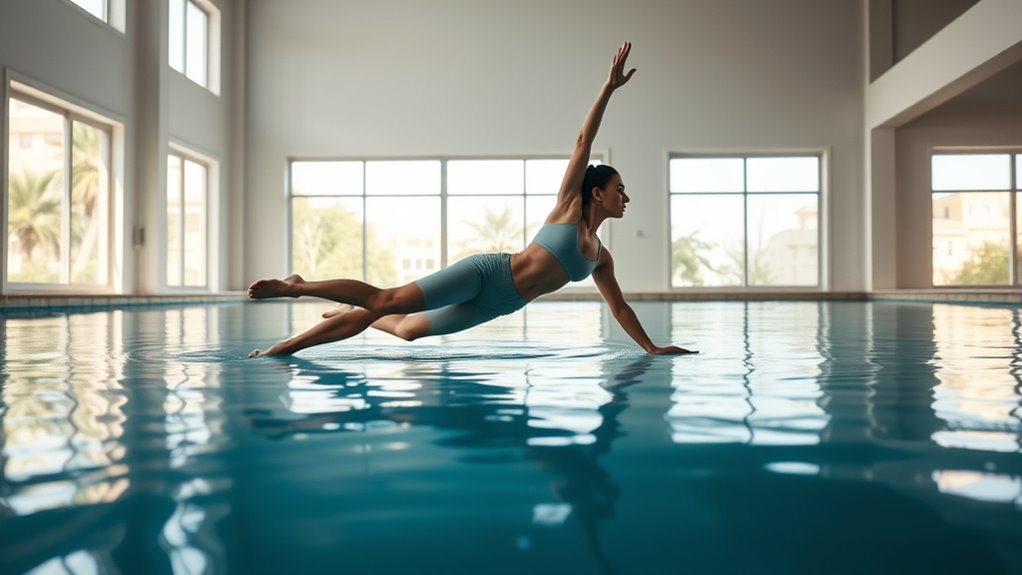
As you progress, you can safely deepen backbends to improve flexibility and strength. Focusing on shoulder flexibility helps open up your upper body, making other poses easier. Enhancing hip mobility allows for smoother movements and greater range of motion in your practice.
Deepening Backbends Safely
Deepening backbends in pool yoga can considerably enhance your flexibility and strength, but it’s crucial to prioritize safety to prevent injury. To do this, listen to your body and avoid pushing beyond your comfort zone. Use the pool’s buoyancy to support your movements, gradually increasing the depth of your backbend. Focus on engaging your core to protect your lower back and ensure proper alignment throughout. Always warm up beforehand to prepare your muscles. Remember to breathe steadily, maintaining a calm, controlled motion. Incorporating proper technique can further reduce the risk of strain or injury.
- Start with gentle, supported backbend poses to build confidence
- Use pool noodles or foam blocks for added support
- Keep movements slow and controlled to avoid overstretching
- Stop immediately if you experience pain or discomfort
Enhancing Shoulder Flexibility
To effectively enhance your shoulder flexibility in pool yoga, focus on intermediate poses that gently increase your range of motion while maintaining safety. Start with shoulder rolls to warm up and loosen tight muscles. Then, try the Water Cross Stretch: extend your arms forward at shoulder height, palms facing down, and slowly open your arms wide, feeling the stretch across your shoulders and chest. Another effective pose is the Pool Side Reach: stand next to a pool wall, extend one arm overhead, and gently pull your elbow with the opposite hand to deepen the stretch. Keep movements controlled and avoid overextending. Incorporating proper technique is essential for preventing injury and maximizing benefits. Consistent practice of these poses helps improve shoulder mobility, reduces tension, and increases flexibility, all while minimizing strain thanks to the buoyant support of the water. Additionally, understanding the importance of automation in business can help you approach your practice with a structured and efficient routine. Engaging in regular practice ensures gradual progress and sustained gains in flexibility over time. Incorporating mindful movement into your routine can further enhance muscle awareness and improve overall effectiveness. Developing a personalized routine tailored to your specific needs can also enhance your progress and comfort during practice.
Improving Hip Mobility
Building on shoulder flexibility, improving hip mobility in pool yoga involves performing intermediate poses that gently increase your range of motion while supporting your joints in water. By engaging in movements like hip circles or gentle lunges, you activate muscles without strain. The buoyancy reduces impact, allowing deeper stretches safely. Focus on controlled, smooth motions to enhance flexibility and joint health. Incorporate these key poses to maximize your progress:
- Water-assisted hip circles
- Supported lunges with water resistance
- Butterfly stretch in waist-deep water
- Side-lying leg lifts with water support
These exercises help loosen tight hips, improve mobility, and prevent stiffness, making everyday movements easier and more comfortable. Consistent practice in the pool boosts your range of motion safely and effectively. Additionally, noise levels of modern heat pumps are designed to be quiet, ensuring your workouts remain undisturbed.
Advanced Flow Sequences for Flexibility and Strength
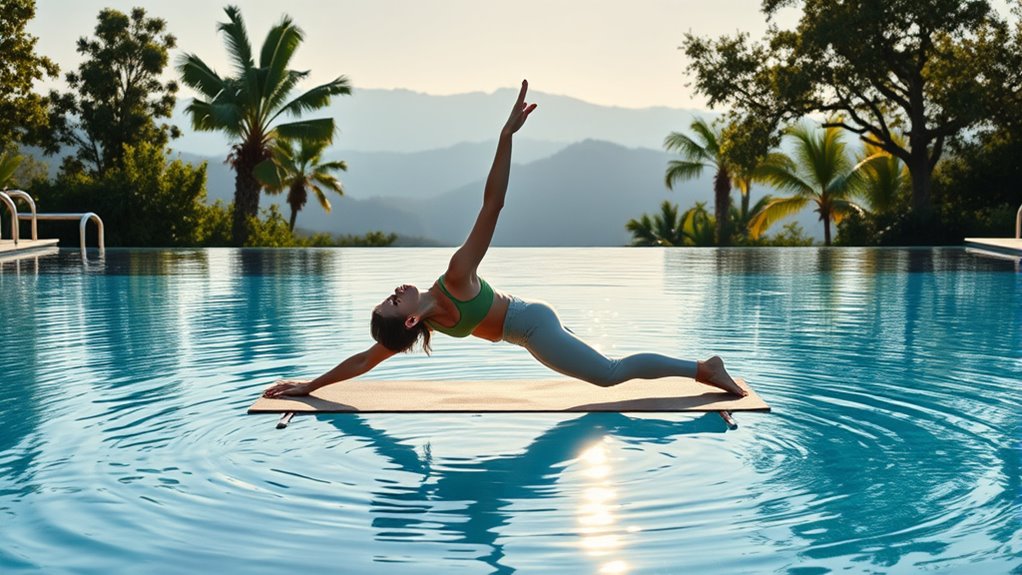
As you progress in pool yoga, incorporating advanced flow sequences can considerably enhance your flexibility and strength. These sequences challenge your muscles and improve your range of motion through dynamic, continuous movements. Try combining poses like Warrior Series with arm and leg extensions, or flowing from Downward Dog to Plank for core engagement. To keep your routines effective, consider this example:
| Sequence Focus | Key Poses |
|---|---|
| Dynamic Flexibility | Sun Salutations, Lunge Variations |
| Strength Building | Plank Variations, Boat Pose |
| Balance and Control | Tree Pose, Warrior III |
Practicing these sequences regularly develops both stability and mobility, pushing your limits safely in the pool environment.
Incorporating Breathing Techniques for Relaxation
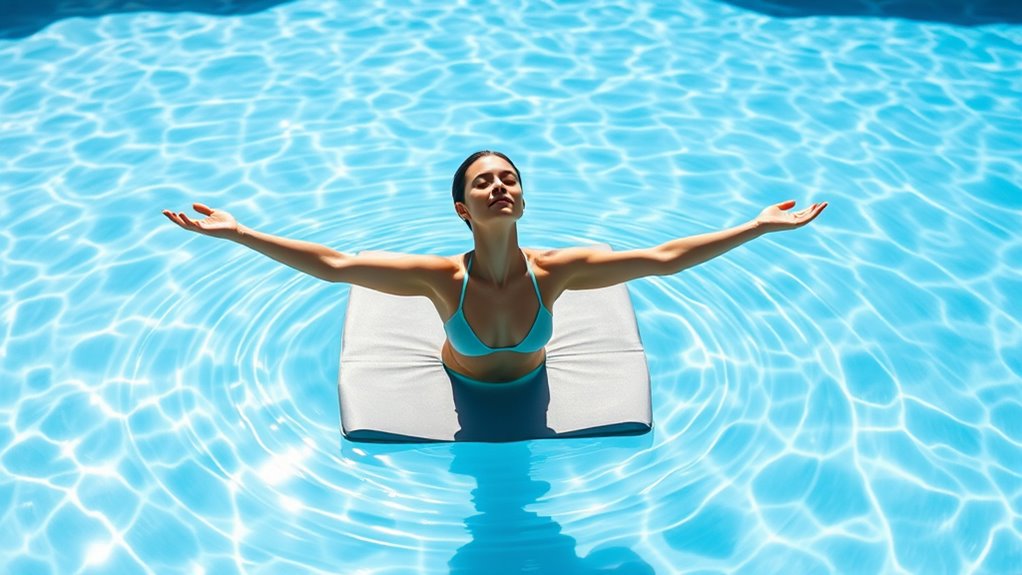
Have you ever noticed how your breath can influence your relaxation and focus during pool yoga? When you breathe deeply and intentionally, you activate your parasympathetic nervous system, helping you unwind and stay present. Incorporating specific breathing techniques can enhance your practice and deepen your sense of calm.
Your breath deepens relaxation and sharpens focus during pool yoga sessions.
Try these methods:
- Deep diaphragmatic breathing to expand your lungs fully and promote relaxation.
- Equal inhale and exhale to maintain a steady, calming rhythm.
- Silent, slow breathing to reduce anxiety and improve concentration.
- Breath counting to anchor your awareness and stay centered during poses.
Creating a Calm Environment for Your Practice
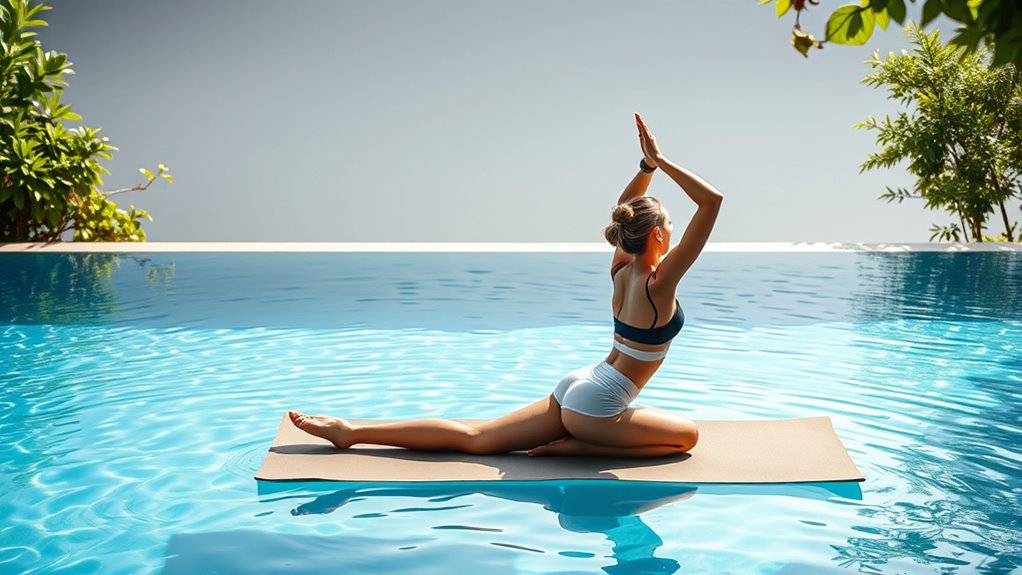
You can set the tone for your pool yoga practice by choosing gentle lighting that soothes your mind. Adding tranquil soundscapes helps create a peaceful atmosphere that enhances focus and relaxation. Small adjustments like these make it easier to relax and fully enjoy your session.
Gentle Lighting Choices
Soft, gentle lighting transforms your pool yoga space into a sanctuary of calm, helping you relax and focus during your practice. Opt for warm, dimmable lights or underwater LED fixtures to create a soothing atmosphere. Avoid harsh, bright bulbs that can cause distraction or discomfort. Use floating candles or lanterns to add a soft glow and enhance the tranquil vibe. Incorporate adjustable lighting options so you can change the mood as needed. Consider placing lights around the perimeter for subtle illumination without overpowering the space. The right lighting encourages relaxation, deepens your focus, and makes your pool yoga session a peaceful retreat from daily stress.
Tranquil Soundscapes Selection
To create a truly calming environment for your pool yoga practice, selecting the right soundscape is essential. Soft, ambient sounds like gentle waves, flowing water, or nature sounds such as birds or rustling leaves can help you relax and focus. Avoid loud or jarring noises that disrupt your concentration. Consider playing calming music with slow tempos and minimal lyrics to maintain a peaceful atmosphere. Using waterproof speakers ensures sound quality without risking damage. Experiment with different sounds to discover what enhances your sense of tranquility. Keep the volume at a comfortable level so the sounds become background ambiance rather than distraction. A well-chosen soundscape helps you stay present and deepens your connection with your practice.
Tips for Consistency and Progress Tracking
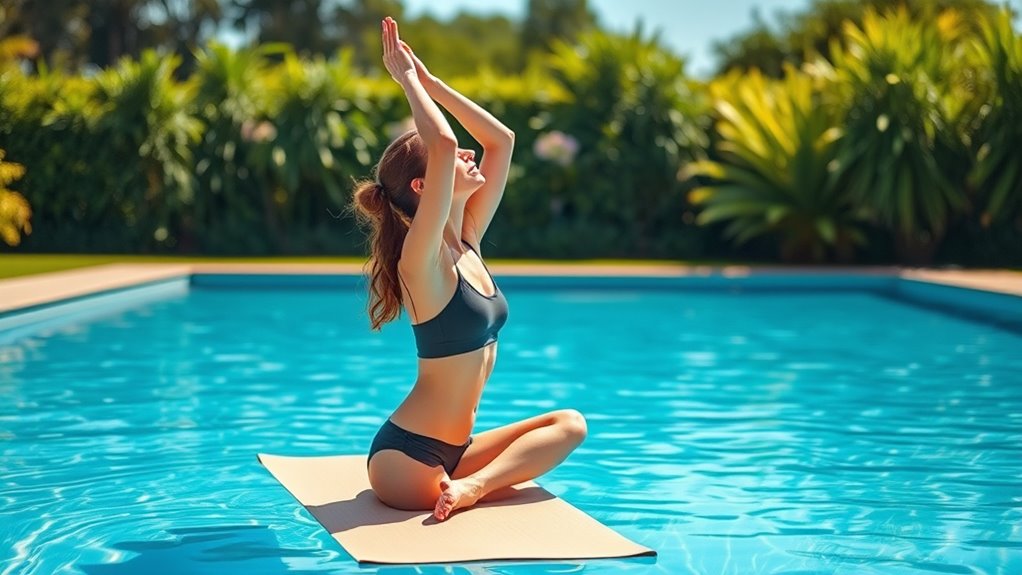
Staying consistent with pool yoga can be challenging, but establishing simple habits makes it easier to track your progress. Set a specific schedule, like practicing three times a week, and stick to it. Keep a journal or use an app to log each session, noting what routines you did and any improvements. Celebrate small milestones to stay motivated. To stay on track, prepare your gear in advance and choose a consistent time and spot in the pool. This creates routine and reduces excuses. Regularly review your progress to identify areas of improvement. Remember, consistency is key to gaining flexibility and enjoying the benefits of pool yoga.
- Schedule sessions at the same time each week
- Keep a workout journal or app
- Set small, achievable goals
- Prepare your gear beforehand
Combining Pool Yoga With Other Fitness Activities
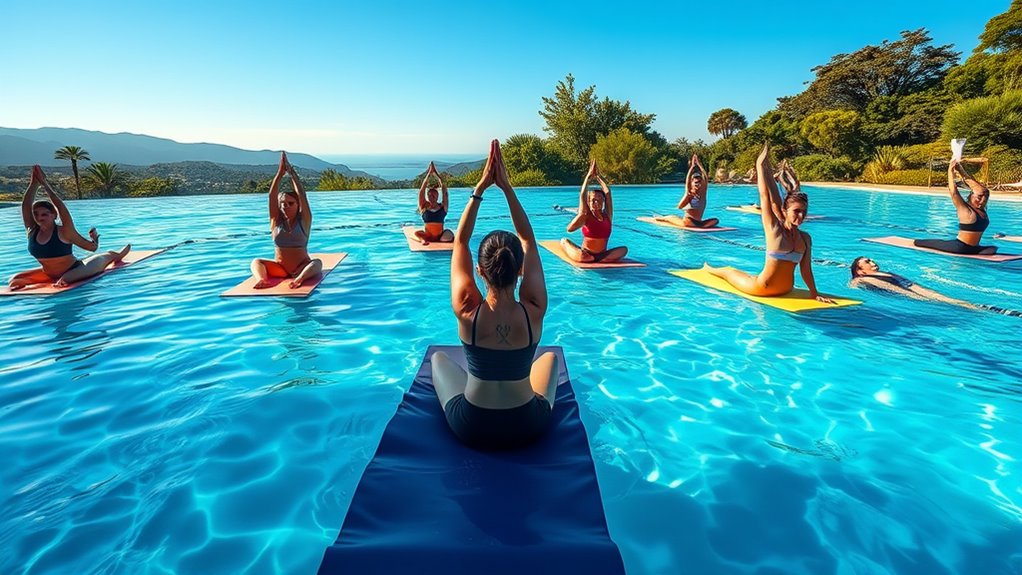
Integrating pool yoga with other fitness activities can enhance your overall workout routine and boost your results. Combining gentle stretches with cardio, strength training, or high-intensity workouts creates a balanced approach that improves flexibility, endurance, and muscle tone. For example, do a quick cardio session before pool yoga to warm up your muscles, or follow yoga with resistance training to target different muscle groups. This variety keeps your routine engaging and prevents plateaus. Pool yoga’s low-impact nature makes it an excellent complement for high-impact activities, reducing injury risk and aiding recovery. By mixing routines, you maximize benefits from each activity while giving your body the variety it needs for sustained progress and overall fitness.
Frequently Asked Questions
Can Pool Yoga Help With Injury Recovery?
You’re wondering if pool yoga can aid injury recovery. It’s a great option because the water’s buoyancy reduces joint strain, allowing you to gently stretch and strengthen muscles without risking further harm. The resistance water provides also helps improve circulation and promotes healing. Just make sure to consult your healthcare provider before starting, and work with a trained instructor to tailor routines to your specific recovery needs.
What Is the Best Time of Day to Practice Pool Yoga?
The best time of day to practice pool yoga depends on your schedule and energy levels. Many find morning sessions energize them for the day ahead, while others prefer evening practice to unwind. You should choose a time when you’re alert and relaxed, ensuring you can focus on your movements and breathing. Consistency matters most, so pick a time that fits easily into your routine for ongoing benefits.
How Often Should I Practice for Noticeable Flexibility Gains?
To see noticeable flexibility gains, you should aim to practice pool yoga at least three to four times a week. Consistency is key, so try to stick to a regular schedule that fits your lifestyle. Focus on gentle, steady movements, and listen to your body. Over time, with regular practice, you’ll notice improvements in your flexibility, mobility, and overall well-being. Keep it enjoyable, and stay committed!
Is Pool Yoga Suitable for Pregnant Women?
You might wonder if pool yoga is safe during pregnancy. It’s gentle and low-impact, making it appealing, but you should always consult your healthcare provider first. Water supports your body, reducing strain and easing joint pain, which is perfect during pregnancy. However, modifications are necessary, and not all routines suit every stage. Always prioritize expert advice to make certain you practice safely and enjoy the benefits without risk.
Are There Any Contraindications for Practicing Pool Yoga?
You should be aware of potential contraindications before practicing pool yoga. If you have open wounds, skin infections, or contagious illnesses, avoid it to prevent infection. Heart conditions, uncontrolled blood pressure, or recent surgeries also require medical approval. Pregnant women and those with joint issues should consult their healthcare provider first. Always listen to your body and stop if you experience pain or discomfort during the session.
Conclusion
Don’t let concerns about your flexibility hold you back—pool yoga is gentle and adaptable for all levels. Even if you’re worried about being new to yoga or feeling stiff, the water’s support makes every movement easier and safer. With regular practice, you’ll build confidence and improve your range of motion without strain. Immerse yourself in pool yoga today and enjoy a soothing, effective way to enhance your flexibility—no prior experience necessary!
